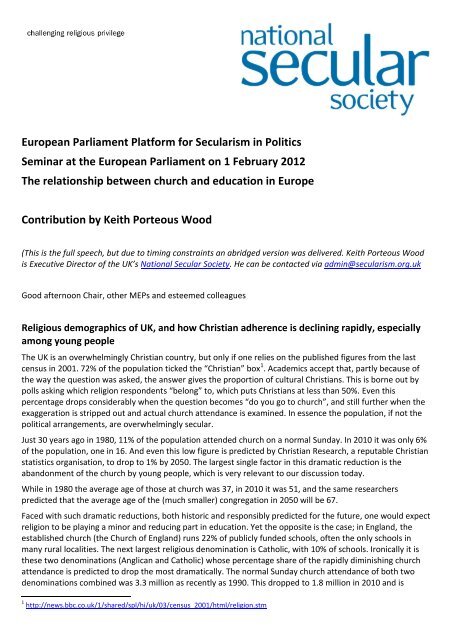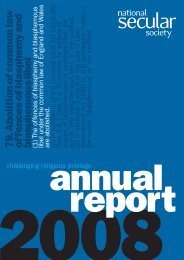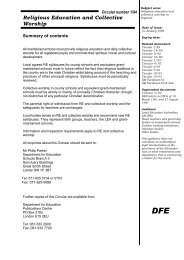European Parliament Platform for Secularism in Politics Seminar at ...
European Parliament Platform for Secularism in Politics Seminar at ...
European Parliament Platform for Secularism in Politics Seminar at ...
You also want an ePaper? Increase the reach of your titles
YUMPU automatically turns print PDFs into web optimized ePapers that Google loves.
<strong>European</strong> <strong>Parliament</strong> <strong>Pl<strong>at</strong><strong>for</strong>m</strong> <strong>for</strong> <strong>Secularism</strong> <strong>in</strong> <strong>Politics</strong><br />
Sem<strong>in</strong>ar <strong>at</strong> the <strong>European</strong> <strong>Parliament</strong> on 1 February 2012<br />
The rel<strong>at</strong>ionship between church and educ<strong>at</strong>ion <strong>in</strong> Europe<br />
Contribution by Keith Porteous Wood<br />
(This is the full speech, but due to tim<strong>in</strong>g constra<strong>in</strong>ts an abridged version was delivered. Keith Porteous Wood<br />
is Executive Director of the UK’s N<strong>at</strong>ional Secular Society. He can be contacted via adm<strong>in</strong>@secularism.org.uk<br />
Good afternoon Chair, other MEPs and esteemed colleagues<br />
Religious demographics of UK, and how Christian adherence is decl<strong>in</strong><strong>in</strong>g rapidly, especially<br />
among young people<br />
The UK is an overwhelm<strong>in</strong>gly Christian country, but only if one relies on the published figures from the last<br />
census <strong>in</strong> 2001. 72% of the popul<strong>at</strong>ion ticked the “Christian” box 1 . Academics accept th<strong>at</strong>, partly because of<br />
the way the question was asked, the answer gives the proportion of cultural Christians. This is borne out by<br />
polls ask<strong>in</strong>g which religion respondents “belong” to, which puts Christians <strong>at</strong> less than 50%. Even this<br />
percentage drops considerably when the question becomes “do you go to church”, and still further when the<br />
exagger<strong>at</strong>ion is stripped out and actual church <strong>at</strong>tendance is exam<strong>in</strong>ed. In essence the popul<strong>at</strong>ion, if not the<br />
political arrangements, are overwhelm<strong>in</strong>gly secular.<br />
Just 30 years ago <strong>in</strong> 1980, 11% of the popul<strong>at</strong>ion <strong>at</strong>tended church on a normal Sunday. In 2010 it was only 6%<br />
of the popul<strong>at</strong>ion, one <strong>in</strong> 16. And even this low figure is predicted by Christian Research, a reputable Christian<br />
st<strong>at</strong>istics organis<strong>at</strong>ion, to drop to 1% by 2050. The largest s<strong>in</strong>gle factor <strong>in</strong> this dram<strong>at</strong>ic reduction is the<br />
abandonment of the church by young people, which is very relevant to our discussion today.<br />
While <strong>in</strong> 1980 the average age of those <strong>at</strong> church was 37, <strong>in</strong> 2010 it was 51, and the same researchers<br />
predicted th<strong>at</strong> the average age of the (much smaller) congreg<strong>at</strong>ion <strong>in</strong> 2050 will be 67.<br />
Faced with such dram<strong>at</strong>ic reductions, both historic and responsibly predicted <strong>for</strong> the future, one would expect<br />
religion to be play<strong>in</strong>g a m<strong>in</strong>or and reduc<strong>in</strong>g part <strong>in</strong> educ<strong>at</strong>ion. Yet the opposite is the case; <strong>in</strong> England, the<br />
established church (the Church of England) runs 22% of publicly funded schools, often the only schools <strong>in</strong><br />
many rural localities. The next largest religious denom<strong>in</strong><strong>at</strong>ion is C<strong>at</strong>holic, with 10% of schools. Ironically it is<br />
these two denom<strong>in</strong><strong>at</strong>ions (Anglican and C<strong>at</strong>holic) whose percentage share of the rapidly dim<strong>in</strong>ish<strong>in</strong>g church<br />
<strong>at</strong>tendance is predicted to drop the most dram<strong>at</strong>ically. The normal Sunday church <strong>at</strong>tendance of both two<br />
denom<strong>in</strong><strong>at</strong>ions comb<strong>in</strong>ed was 3.3 million as recently as 1990. This dropped to 1.8 million <strong>in</strong> 2010 and is<br />
1 http://news.bbc.co.uk/1/shared/spl/hi/uk/03/census_2001/html/religion.stm
projected to drop to less than 0.2 million by 2050. 200,000 very elderly congregants each Sunday are not<br />
remotely enough to susta<strong>in</strong> two n<strong>at</strong>ionwide religious <strong>in</strong>stitutions.<br />
The equivalent figures <strong>for</strong> those less than 20 years old are even more dram<strong>at</strong>ic: 1.7 million <strong>in</strong> 1990, 0.5 million<br />
<strong>in</strong> 2010 and 14,300 <strong>in</strong> 2050.<br />
Northern Ireland<br />
There are major n<strong>at</strong>ional and regional vari<strong>at</strong>ions with<strong>in</strong> the United K<strong>in</strong>gdom. The most notable of these is the<br />
much higher degree of religious belief and adherence <strong>in</strong> Northern Ireland, perhaps itself a problem <strong>in</strong> th<strong>at</strong> the<br />
high level of religious belief and sense of identity probably contributes to the cont<strong>in</strong>u<strong>in</strong>g sectarian problems.<br />
While armed hostilities are now much less common, the so-called peace walls <strong>in</strong> Belfast rema<strong>in</strong> by common<br />
consent, and <strong>in</strong>deed still seem necessary. In such a clim<strong>at</strong>e, the need <strong>for</strong> non-sectarian educ<strong>at</strong>ion is too<br />
obvious to st<strong>at</strong>e. It has been acknowledged, and there is an <strong>in</strong>tegr<strong>at</strong>ed schools movement; essentially their<br />
schools are religious schools, but nondenom<strong>in</strong><strong>at</strong>ional. Yet only 5% of pupils <strong>at</strong>tend such schools, which we<br />
suspect are generally not <strong>in</strong> the areas where they are most needed.<br />
Scotland<br />
Scotland is less religious than Northern Ireland but more religious than England and Wales. The local authority<br />
run schools are called “non-denom<strong>in</strong><strong>at</strong>ional schools”, but despite the title are probably the nearest to secular<br />
schools th<strong>at</strong> the United K<strong>in</strong>gdom gets. There are legal provisions <strong>for</strong> religious observance, but much less<br />
prescriptive than the almost-obsessive daily worship requirement imposed by law on all publicly funded<br />
English schools. Such daily worship would not be unlawful <strong>in</strong> Scotland, but the less prescriptive legisl<strong>at</strong>ion is<br />
presumably born out of dissent<strong>in</strong>g views <strong>in</strong> the absence of a powerful established church with its bishops <strong>in</strong><br />
<strong>Parliament</strong>. (The Church of Scotland is generally regarded as the n<strong>at</strong>ional Church. It does not have bishops. All<br />
26 bishops entitled to sit <strong>in</strong> the UK <strong>Parliament</strong> are from the Church of England, and of course all male.)<br />
England<br />
As England is by far the largest jurisdiction, I will concentr<strong>at</strong>e my rema<strong>in</strong><strong>in</strong>g remarks on England.<br />
Despite the dram<strong>at</strong>ic reduction <strong>in</strong> churchgo<strong>in</strong>g by young people (71% between 1990 and 2010), the<br />
proportion of publicly funded religious schools is actually grow<strong>in</strong>g, because the Government is k<strong>in</strong>dly disposed<br />
to religious schools.<br />
Given these figures, it would be reasonable to assume th<strong>at</strong> the religious schools would be almost devoid of<br />
pupils, but the opposite is the case. Religious schools are popular, and many are oversubscribed - but why?<br />
The answer is th<strong>at</strong>, unlike community schools (those run by the local authority without a specifically religious<br />
ethos), many of the religious schools are permitted to select pupils. Official st<strong>at</strong>istics and academic studies<br />
show th<strong>at</strong> this results <strong>in</strong> them cherry-pick<strong>in</strong>g the most promis<strong>in</strong>g pupils, or <strong>at</strong> least avoid<strong>in</strong>g disruptive and<br />
difficult-to-teach pupils. On average there<strong>for</strong>e, unsurpris<strong>in</strong>gly, the exam<strong>in</strong><strong>at</strong>ion results of religious schools<br />
tend to be better than community schools. This is because aspirant parents - the biggest predictor of their<br />
child’s academic success - are keen, even if they are not religious, <strong>for</strong> their children to <strong>at</strong>tend such schools.<br />
This illusory cycle of advantage has a victim: community schools. They take the children not selected by the<br />
religious schools; and it is surpris<strong>in</strong>g th<strong>at</strong> the disparity <strong>in</strong> results compared with religious schools is not much<br />
larger.<br />
Wh<strong>at</strong> the vast majority of parents want is good schools, not religious schools. Such is the pressure on places <strong>in</strong><br />
religious schools, they are often able to make unreasonable demands on parents as a condition of admitt<strong>in</strong>g<br />
their child to school. We are even aware of a school th<strong>at</strong> requires parents to <strong>at</strong>tend the school’s church 48<br />
times per year. It has become an accepted part of middle-class life <strong>for</strong> parents to <strong>at</strong>tend church when they<br />
would not otherwise do so, simply to secure admission <strong>for</strong> their child to the local church school. When do<strong>in</strong>g<br />
so they often make ostent<strong>at</strong>ious don<strong>at</strong>ions and volunteer to per<strong>for</strong>m unpaid work <strong>for</strong> the church. Given this,<br />
it is remarkable th<strong>at</strong> the church <strong>at</strong>tendance figures cont<strong>in</strong>ue their dram<strong>at</strong>ic decl<strong>in</strong>e.<br />
The many families th<strong>at</strong> are not religious, and not prepared to pretend th<strong>at</strong> they are, are seriously<br />
disadvantaged <strong>in</strong> the educ<strong>at</strong>ion system. In rural areas <strong>in</strong> particular, the only school with<strong>in</strong> practical travell<strong>in</strong>g<br />
distance will often be local church school. Even where a family lives close to the school, parents may have
difficulty <strong>in</strong> hav<strong>in</strong>g their child admitted, because preference is given to religious families (of those who<br />
pretend to be religious) from further away. For parents not prepared to pretend to be religious, there are<br />
likely to be far fewer good schools <strong>in</strong> the locality to which they have a reasonable chance of hav<strong>in</strong>g their child<br />
admitted. In contrast, those who are, or pretend to be, religious have preferential access to religious schools,<br />
and no correspond<strong>in</strong>g disadvantage <strong>in</strong> admission to the non-religious schools (not th<strong>at</strong> I'm advoc<strong>at</strong><strong>in</strong>g th<strong>at</strong><br />
this should be a disadvantage).<br />
There<strong>for</strong>e, overall, the non-religious and non-concerned (certa<strong>in</strong>ly the majority of the popul<strong>at</strong>ion) are <strong>at</strong> a<br />
considerable disadvantage rel<strong>at</strong>ive to the religious.<br />
In the United K<strong>in</strong>gdom we have just emerged from a mar<strong>at</strong>hon of an Educ<strong>at</strong>ion Bill which took almost all of<br />
2011 to pass through <strong>Parliament</strong>. I say “mar<strong>at</strong>hon” because we were very active <strong>in</strong> oppos<strong>in</strong>g much <strong>in</strong> the Bill,<br />
and I will pick two areas on which we deb<strong>at</strong>ed most relevant to our discussions today:<br />
1. Mand<strong>at</strong>ory Worship <strong>in</strong> Schools In England and Wales all schools, even those unconnected with the<br />
churches, are required by law to conduct a daily worship <strong>in</strong> publicly funded schools. We proposed this<br />
be discont<strong>in</strong>ued dur<strong>in</strong>g the passage of the Educ<strong>at</strong>ion Bill. One of our parliamentarians engaged <strong>in</strong> the<br />
deb<strong>at</strong>e suggested the reason th<strong>at</strong> this completely <strong>in</strong>appropri<strong>at</strong>e practice still rema<strong>in</strong>ed <strong>in</strong> England and<br />
Wales alone <strong>in</strong> Europe was because the UK is the only country, with the possible exception of Iran, to<br />
give clerics - 26 bishops – the right to sit <strong>in</strong> its legisl<strong>at</strong>ure.<br />
2. Discrim<strong>in</strong><strong>at</strong>ion Aga<strong>in</strong>st Non-Religious Teachers We also opposed discrim<strong>in</strong><strong>at</strong>ion aga<strong>in</strong>st non-religious<br />
teachers be<strong>in</strong>g permitted by st<strong>at</strong>ute. Despite a number of legal op<strong>in</strong>ions th<strong>at</strong> this is <strong>in</strong> breach of the EU<br />
Employment Directive, the Government - clearly still frightened of the established church - refuses to<br />
remove the discrim<strong>in</strong><strong>at</strong>ory provisions. We have there<strong>for</strong>e lodged a <strong>for</strong>mal compla<strong>in</strong>t with the<br />
<strong>European</strong> Commission. The Commission is responsible <strong>for</strong> mak<strong>in</strong>g sure th<strong>at</strong> EU directives are complied<br />
with. The Employment Directive <strong>in</strong>cludes, among other grounds, sexual orient<strong>at</strong>ion, and religion or<br />
belief. Importantly, “belief” <strong>in</strong> this context means non-belief. Most of the problems to do with<br />
discrim<strong>in</strong><strong>at</strong>ion <strong>in</strong> employment <strong>in</strong> educ<strong>at</strong>ion rel<strong>at</strong>e <strong>in</strong> some way to religion and belief or sexuality.<br />
Others, <strong>for</strong> example the dismissal of unmarried staff <strong>for</strong> becom<strong>in</strong>g pregnant, may need to be tackled as<br />
a breach of human rights, which may require an expensive court case.<br />
Conclusion on the UK<br />
You can see then th<strong>at</strong>, despite low and decl<strong>in</strong><strong>in</strong>g Christian adherence <strong>in</strong> Brita<strong>in</strong>, the <strong>in</strong>volvement and power of<br />
religion <strong>in</strong> educ<strong>at</strong>ion rema<strong>in</strong>s very high <strong>in</strong>deed. No political party leader <strong>in</strong> recent decades has ever dared to<br />
take on the religious establishment, even though it is becom<strong>in</strong>g more and more out of touch with its own<br />
congregants, far less <strong>in</strong> touch with the popul<strong>at</strong>ion as a whole. This is the very antithesis of secularism. In<br />
British schools, the non-religious and religiously unconcerned (comb<strong>in</strong>ed, a majority) are second class citizens.<br />
Wh<strong>at</strong> remedies do we have <strong>in</strong> the EU?<br />
The <strong>Pl<strong>at</strong><strong>for</strong>m</strong>’s chair, Sophie <strong>in</strong> ’t Veld, has also asked us to consider “how can the EU ensure, without<br />
prejudice to the n<strong>at</strong>ional competences <strong>in</strong> m<strong>at</strong>ters of educ<strong>at</strong>ion, th<strong>at</strong> the pr<strong>in</strong>ciples of equality and non<br />
discrim<strong>in</strong><strong>at</strong>ion are upheld?”<br />
The overall suggestion I have is to make full use of the EU's Charter of Fundamental Rights, its Directives and<br />
its <strong>in</strong>stitutions, and perhaps also those of the Council of Europe, and if necessary the United N<strong>at</strong>ions. In the<br />
short time rema<strong>in</strong><strong>in</strong>g I will make a few practical suggestions most likely to be relevant to our concerns <strong>in</strong><br />
educ<strong>at</strong>ion.<br />
The Commission has sections concerned with discrim<strong>in</strong><strong>at</strong>ion and fundamental rights. If you have evidence of<br />
significant breaches of EU law, it is worthwhile logg<strong>in</strong>g your compla<strong>in</strong>ts with the Commission.<br />
I have followed my own advice over Directive en<strong>for</strong>cement and have separ<strong>at</strong>e compla<strong>in</strong>ts outstand<strong>in</strong>g <strong>in</strong><br />
respect of England and Scotland. They rel<strong>at</strong>e to wh<strong>at</strong> we believe, after tak<strong>in</strong>g legal advice, to be the failure of
the UK Government to correctly transpose the Employment Directive <strong>in</strong>to UK law. The specific area of our<br />
compla<strong>in</strong>ts rel<strong>at</strong>es to <strong>in</strong>sufficient protection from discrim<strong>in</strong><strong>at</strong>ion <strong>for</strong> non-religious teachers.<br />
For more str<strong>at</strong>egic concerns, I believe we should be mak<strong>in</strong>g gre<strong>at</strong>er use of the EU Fundamental Rights Agency.<br />
They emerged out of an organis<strong>at</strong>ion concerned pr<strong>in</strong>cipally with racism and migrants, but now have a much<br />
broader remit. Anyone can approach them with concerns.<br />
I suggest the follow<strong>in</strong>g subject areas likely to be of specific concern:<br />
Equality between men and women<br />
Inadequ<strong>at</strong>e or poor sex educ<strong>at</strong>ion, often because of religious <strong>in</strong>fluences<br />
Cre<strong>at</strong>ionism be<strong>in</strong>g taught as a scientific “fact”<br />
Homophobia, or simply failure to recognise and respect any sexual orient<strong>at</strong>ions th<strong>at</strong> are not<br />
heterosexual.<br />
In the appendix which follows, I summarise m<strong>at</strong>erial, mostly from the EU, th<strong>at</strong> will I hope be a helpful resource<br />
<strong>in</strong> comb<strong>at</strong><strong>in</strong>g these problems.<br />
EU conclusion<br />
Wh<strong>at</strong> my colleagues have said <strong>in</strong> their contributions about educ<strong>at</strong>ion <strong>in</strong> the Flemish part of Belgium and<br />
particularly <strong>in</strong> Hungary, have been shock<strong>in</strong>g. Some of the outrages they c<strong>at</strong>alogue are ones th<strong>at</strong> also apply to<br />
the UK. Listen<strong>in</strong>g also to the contributions from the floor, I realise th<strong>at</strong> the situ<strong>at</strong>ion is <strong>in</strong>tolerable <strong>in</strong> many<br />
Member St<strong>at</strong>es, but overlooked because of the churches’ overbear<strong>in</strong>g <strong>in</strong>fluence.<br />
Educ<strong>at</strong>ion is the place where the lack of secularism imp<strong>in</strong>ges most harshly on the ord<strong>in</strong>ary citizen. They need<br />
our help. This issue there<strong>for</strong>e needs to be tackled on a Europe wide basis. I hope we can f<strong>in</strong>d a way of do<strong>in</strong>g<br />
so.
APPENDIX<br />
Equality between men and women<br />
Equality between women and men is one of the fundamental pr<strong>in</strong>ciples of Community law. The <strong>European</strong><br />
Union’s (EU) objectives on gender equality are to ensure equal opportunities and equal tre<strong>at</strong>ment <strong>for</strong> men<br />
and women and to comb<strong>at</strong> any <strong>for</strong>m of discrim<strong>in</strong><strong>at</strong>ion on the grounds of gender. The EU has adopted a twopronged<br />
approach to this issue, comb<strong>in</strong><strong>in</strong>g specific measures with gender ma<strong>in</strong>stream<strong>in</strong>g. The issue also has a<br />
strong <strong>in</strong>tern<strong>at</strong>ional dimension with regard to the fight aga<strong>in</strong>st poverty, access to educ<strong>at</strong>ion and health<br />
services, tak<strong>in</strong>g part <strong>in</strong> the economy and <strong>in</strong> the decision-mak<strong>in</strong>g process, women's rights and human rights.<br />
GENERAL FRAMEWORK<br />
Gender ma<strong>in</strong>stream<strong>in</strong>g<br />
•Str<strong>at</strong>egy <strong>for</strong> equality between women and men 2010-2015<br />
•Strengthen<strong>in</strong>g the commitment to equality between women and men: a women’s charter<br />
•Roadmap <strong>for</strong> equality between women and men (2006-2010) Archives<br />
•Fifth Community Action Programme on Equal Opportunities (2001-2006) Archives<br />
•Incorpor<strong>at</strong>ion of equal opportunities <strong>in</strong>to Community policies Archives<br />
F<strong>in</strong>ancial aspects<br />
•Community programme <strong>for</strong> employment and solidarity - PROGRESS (2007-2013)<br />
•<strong>European</strong> Progress Microf<strong>in</strong>ance Facility (EPMF)<br />
•”EQUAL”<br />
•Gender ma<strong>in</strong>stream<strong>in</strong>g with<strong>in</strong> the Structural Funds Archives<br />
•Promotion of organis<strong>at</strong>ions active <strong>in</strong> the field of equality between men and women (2004-2006) Archives<br />
Reports<br />
•Reports on equality between women and men – by year<br />
Institutional aspects<br />
•<strong>European</strong> Institute <strong>for</strong> Gender Equality<br />
•Advisory Committee on Equal Opportunities <strong>for</strong> Men and Women<br />
•Gender balance with<strong>in</strong> the committees and expert groups set up by the Commission<br />
PRINCIPLE OF NON-DISCRIMINATION BASED ON SEX<br />
•The pr<strong>in</strong>ciple of equal tre<strong>at</strong>ment <strong>for</strong> men and women outside the labour market<br />
•Burden of proof <strong>in</strong> cases of discrim<strong>in</strong><strong>at</strong>ion based on sex<br />
FEMALE EMPLOYMENT AND ENTREPRENEURSHIP<br />
Employment
•Tackl<strong>in</strong>g the pay gap between men and women<br />
•Gender equality <strong>in</strong> the labour market<br />
•Equal tre<strong>at</strong>ment as regards access to employment, voc<strong>at</strong>ional tra<strong>in</strong><strong>in</strong>g and promotion<br />
•Self-employed workers: equal tre<strong>at</strong>ment between men and women<br />
•Equal tre<strong>at</strong>ment of self-employed workers (until 2012)<br />
•Equal pay<br />
•Balanced particip<strong>at</strong>ion of women and men <strong>in</strong> the decision-mak<strong>in</strong>g process<br />
•The <strong>in</strong>tegr<strong>at</strong>ion of women <strong>in</strong> research<br />
Social dimension<br />
•Parental leave<br />
•Promot<strong>in</strong>g solidarity between the gener<strong>at</strong>ions<br />
•Balanced particip<strong>at</strong>ion of women and men <strong>in</strong> family and work<strong>in</strong>g life<br />
•Protection of pregnant workers and workers who have recently given birth or are breastfeed<strong>in</strong>g<br />
•Childcare<br />
•Social security<br />
•Parental leave and leave <strong>for</strong> family reasons<br />
•Occup<strong>at</strong>ional pension schemes<br />
COMBATING SEXUAL HARASSMENT AND VIOLENCE AGAINST WOMEN<br />
Comb<strong>at</strong><strong>in</strong>g sexual harassment<br />
•Protection of the dignity of women and men <strong>at</strong> work<br />
•Code of practice to clamp down on sexual harassment <strong>at</strong> work<br />
•Prevent<strong>in</strong>g sexual harassment <strong>at</strong> work<br />
Comb<strong>at</strong><strong>in</strong>g violence, sexual exploit<strong>at</strong>ion and traffick<strong>in</strong>g <strong>in</strong> women<br />
•New measures to comb<strong>at</strong> traffick<strong>in</strong>g <strong>in</strong> women<br />
•Traffick<strong>in</strong>g <strong>in</strong> women <strong>for</strong> the purpose of sexual exploit<strong>at</strong>ion<br />
INTERNATIONAL DIMENSION OF EQUALITY BETWEEN MEN AND WOMEN<br />
•Str<strong>at</strong>egy <strong>for</strong> gender equality <strong>in</strong> development policy<br />
•Fourth United N<strong>at</strong>ions Conference on Women<br />
http://europa.eu/legisl<strong>at</strong>ion_summaries/employment_and_social_policy/equality_between_men_and_wome<br />
n/<strong>in</strong>dex_en.htm<br />
Sex Educ<strong>at</strong>ion<br />
Here are some resources which should help <strong>in</strong> br<strong>in</strong>g<strong>in</strong>g pressure to bear over <strong>in</strong>adequ<strong>at</strong>e sex educ<strong>at</strong>ion.<br />
The Charter of EU fundamental rights, which the FRA works to support, <strong>in</strong>cludes both discrim<strong>in</strong><strong>at</strong>ion<br />
provisions and Article 24 - The Rights of the Child. Article 24.1 reads “Children shall have the right to such
protection and care as is necessary <strong>for</strong> their well-be<strong>in</strong>g. They may express their views freely. Such views shall<br />
be taken <strong>in</strong>to consider<strong>at</strong>ion on m<strong>at</strong>ters which concern them <strong>in</strong> accordance with their age and m<strong>at</strong>urity.”<br />
Article 17 of the UN Convention on the Rights of the Child calls on St<strong>at</strong>es to ensure th<strong>at</strong> children have access<br />
to <strong>in</strong><strong>for</strong>m<strong>at</strong>ion and m<strong>at</strong>erial from a diversity of n<strong>at</strong>ional and <strong>in</strong>tern<strong>at</strong>ional sources aimed <strong>at</strong> the promotion of<br />
their social, spiritual and moral well-be<strong>in</strong>g and physical and mental health.<br />
http://www2.ohchr.org/english/law/crc.htm<br />
The Safe Guide: This <strong>in</strong>valuable guide was f<strong>in</strong>ancially supported by the <strong>European</strong> Commission Director<strong>at</strong>e<br />
General <strong>for</strong> Health and Consumer Protection, as part of 'The SAFE Project: A <strong>European</strong> partnership to promote<br />
the sexual and reproductive health and rights of young people.'<br />
The project is a partnership between IPPF <strong>European</strong> Network, WHO Regional Office <strong>for</strong> Europe and Lund<br />
University. It aims to build on exist<strong>in</strong>g research <strong>in</strong> the field, to provide an overall picture of the p<strong>at</strong>terns and<br />
trends across the region, to develop new and <strong>in</strong>nov<strong>at</strong>ive ways to reach young people with SRHR <strong>in</strong><strong>for</strong>m<strong>at</strong>ion<br />
and services, and to <strong>in</strong><strong>for</strong>m, support and advance policy development. The guide provides <strong>in</strong><strong>for</strong>m<strong>at</strong>ion about<br />
sexuality educ<strong>at</strong>ion <strong>in</strong> 26 <strong>European</strong> countries, and reflects the reality th<strong>at</strong> policies and practices rel<strong>at</strong>ed to<br />
young people's sexual and reproductive health and rights - <strong>in</strong>clud<strong>in</strong>g sexuality educ<strong>at</strong>ion - vary from country<br />
to country. Young people need accur<strong>at</strong>e <strong>in</strong><strong>for</strong>m<strong>at</strong>ion, skills and access to youth-friendly sexual and<br />
reproductive health services if they are to make healthy, <strong>in</strong><strong>for</strong>med choices. Comprehensive sexuality<br />
educ<strong>at</strong>ion is one of the most important tools we have to ensure th<strong>at</strong> young people have the <strong>in</strong><strong>for</strong>m<strong>at</strong>ion they<br />
need. http://www2.hu-berl<strong>in</strong>.de/sexology/BIB/SexEd/SexEd.html<br />
This is a summary<br />
Sexuality Educ<strong>at</strong>ion must help young people to:<br />
• Acquire accur<strong>at</strong>e <strong>in</strong><strong>for</strong>m<strong>at</strong>ion<br />
On sexual and reproductive rights; <strong>in</strong><strong>for</strong>m<strong>at</strong>ion to dispel myths; references to resources and services<br />
• Develop life skills<br />
Such as critical th<strong>in</strong>k<strong>in</strong>g, communic<strong>at</strong>ion and negoti<strong>at</strong>ion skills, self-development skills, decision mak<strong>in</strong>g skills;<br />
sense of self; confidence; assertiveness; ability to take responsibility; ability to ask questions and seek help;<br />
emp<strong>at</strong>hy<br />
• Nurture positive <strong>at</strong>titudes and values<br />
Open-m<strong>in</strong>dedness; respect <strong>for</strong> self and others; positive self-worth/esteem; com<strong>for</strong>t; non-judgmental <strong>at</strong>titude;<br />
sense of responsibility; positive <strong>at</strong>titude toward their sexual and reproductive health<br />
Sexuality educ<strong>at</strong>ion covers a broad range of issues rel<strong>at</strong><strong>in</strong>g to both the physical and biological aspects of<br />
sexuality, and the emotional and social aspects. It recognizes and accepts all people as sexual be<strong>in</strong>gs and is<br />
concerned with more than just the prevention of disease or pregnancy. CSE programmes should be adapted<br />
to the age and stage of development of the target group.<br />
Which factors h<strong>in</strong>der and enhance provision and how can they be addressed?<br />
Cross-n<strong>at</strong>ional comparisons reveal common factors <strong>in</strong>fluenc<strong>in</strong>g the rel<strong>at</strong>ive ease of implement<strong>at</strong>ion of<br />
sexuality educ<strong>at</strong>ion. To vary<strong>in</strong>g degrees, the subject is controversial virtually everywhere. Thus, there is<br />
considerable scope <strong>for</strong> shar<strong>in</strong>g lessons learned from one <strong>European</strong> country with another, particularly with<br />
regard to the follow<strong>in</strong>g factors.<br />
• Reconcil<strong>in</strong>g political and religious views<br />
Very few countries exhibit complete acceptance of sexuality educ<strong>at</strong>ion across all groups, and political context<br />
exerts a strong <strong>in</strong>fluence on implement<strong>at</strong>ion. In countries such as the Netherlands and Denmark, sexuality<br />
educ<strong>at</strong>ion is widely accepted and supported, while <strong>in</strong> other countries there is still strong opposition and a lack<br />
of support. Even <strong>in</strong> the Netherlands, anti-choice groups and <strong>in</strong>dividuals are vocal <strong>in</strong> their opposition. In<br />
predom<strong>in</strong>antly C<strong>at</strong>holic countries such as Ireland, objections are <strong>for</strong>cefully made and extend to the provision
of sexual health services as well as educ<strong>at</strong>ion. The collapse of communism <strong>in</strong> some Central and Eastern<br />
<strong>European</strong> countries, such as Poland, the Czech Republic and Slovakia, cre<strong>at</strong>ed conditions <strong>for</strong> the revival of<br />
C<strong>at</strong>holic <strong>in</strong>terest. While <strong>in</strong> Germany, persistent Roman C<strong>at</strong>holic-<strong>in</strong>spired anti-choice opposition cre<strong>at</strong>es a<br />
difficult clim<strong>at</strong>e <strong>in</strong> which to implement sexuality educ<strong>at</strong>ion curricula. And <strong>in</strong> several countries, there is<br />
evidence th<strong>at</strong> Muslim faith groups oppose sexuality educ<strong>at</strong>ion as it is currently provided. Much has been<br />
achieved <strong>in</strong> actively <strong>in</strong>volv<strong>in</strong>g religious organiz<strong>at</strong>ions <strong>in</strong> sexuality educ<strong>at</strong>ion <strong>in</strong> partnership. In Portugal, <strong>for</strong><br />
example, NGOs <strong>in</strong>volved <strong>in</strong>clude the Pro-Life Movement; <strong>in</strong> Ireland, a C<strong>at</strong>holic marriage support agency is<br />
used to deliver aspects of the Rel<strong>at</strong>ionship and Sexuality Educ<strong>at</strong>ion (RSE)/ Social Personal and Health<br />
Educ<strong>at</strong>ion (SPHE) programme; <strong>in</strong> Greece, the church is <strong>in</strong>volved <strong>in</strong> implement<strong>in</strong>g sexuality educ<strong>at</strong>ion, as well<br />
as curriculum implement<strong>at</strong>ion (<strong>in</strong>clud<strong>in</strong>g enlist<strong>in</strong>g support from appropri<strong>at</strong>e authorities).<br />
Cre<strong>at</strong>ionism<br />
Resolution 1580 (2007)<br />
Assembly deb<strong>at</strong>e on 4 October 2007 (35th Sitt<strong>in</strong>g) (see Doc. 11375, report of the Committee on Culture,<br />
Science and Educ<strong>at</strong>ion, rapporteur: Mrs Brasseur). Text adopted by the Assembly on 4 October 2007<br />
(35th Sitt<strong>in</strong>g).<br />
http://assembly.coe.<strong>in</strong>t/ma<strong>in</strong>.asp?l<strong>in</strong>k=/documents/adoptedtext/ta07/eres1580.htm<br />
The dangers of cre<strong>at</strong>ionism <strong>in</strong> educ<strong>at</strong>ion<br />
1. The aim of this resolution is not to question or to fight a belief – the right to freedom of belief does not<br />
permit th<strong>at</strong>. The aim is to warn aga<strong>in</strong>st certa<strong>in</strong> tendencies to pass off a belief as science. It is necessary to<br />
separ<strong>at</strong>e belief from science. It is not a m<strong>at</strong>ter of antagonism. Science and belief must be able to coexist. It is<br />
not a m<strong>at</strong>ter of oppos<strong>in</strong>g belief and science, but it is necessary to prevent belief from oppos<strong>in</strong>g science.<br />
2. For some people the Cre<strong>at</strong>ion, as a m<strong>at</strong>ter of religious belief, gives a mean<strong>in</strong>g to life. Nevertheless, the<br />
<strong>Parliament</strong>ary Assembly is worried about the possible ill-effects of the spread of cre<strong>at</strong>ionist ideas with<strong>in</strong> our<br />
educ<strong>at</strong>ion systems and about the consequences <strong>for</strong> our democracies. If we are not careful, cre<strong>at</strong>ionism could<br />
become a thre<strong>at</strong> to human rights, which are a key concern of the Council of Europe.<br />
3. Cre<strong>at</strong>ionism, born of the denial of the evolution of species through n<strong>at</strong>ural selection, was <strong>for</strong> a long time an<br />
almost exclusively American phenomenon. Today cre<strong>at</strong>ionist ideas are tend<strong>in</strong>g to f<strong>in</strong>d their way <strong>in</strong>to Europe<br />
and their spread is affect<strong>in</strong>g quite a few Council of Europe member st<strong>at</strong>es.<br />
4. The prime target of present-day cre<strong>at</strong>ionists, most of whom are of the Christian or Muslim faith, is<br />
educ<strong>at</strong>ion. Cre<strong>at</strong>ionists are bent on ensur<strong>in</strong>g th<strong>at</strong> their ideas are <strong>in</strong>cluded <strong>in</strong> the school science syllabuses.<br />
Cre<strong>at</strong>ionism cannot, however, lay claim to be<strong>in</strong>g a scientific discipl<strong>in</strong>e.<br />
5. Cre<strong>at</strong>ionists question the scientific character of certa<strong>in</strong> areas of knowledge and argue th<strong>at</strong> the theory of<br />
evolution is only one <strong>in</strong>terpret<strong>at</strong>ion among others. They accuse scientists of not provid<strong>in</strong>g enough evidence to<br />
establish the theory of evolution as scientifically valid. On the contrary, cre<strong>at</strong>ionists defend their own<br />
st<strong>at</strong>ements as scientific. None of this stands up to objective analysis.<br />
6. We are witness<strong>in</strong>g a growth of modes of thought which challenge established knowledge about n<strong>at</strong>ure,<br />
evolution, our orig<strong>in</strong>s and our place <strong>in</strong> the universe.<br />
7. There is a real risk of serious confusion be<strong>in</strong>g <strong>in</strong>troduced <strong>in</strong>to our children’s m<strong>in</strong>ds between wh<strong>at</strong> has to do<br />
with convictions, beliefs, ideals of all sorts and wh<strong>at</strong> has to do with science. An “all th<strong>in</strong>gs are equal” <strong>at</strong>titude<br />
may seem appeal<strong>in</strong>g and tolerant, but is <strong>in</strong> fact dangerous.<br />
8. Cre<strong>at</strong>ionism has many contradictory aspects. The “<strong>in</strong>telligent design” idea, which is the l<strong>at</strong>est, more ref<strong>in</strong>ed<br />
version of cre<strong>at</strong>ionism, does not deny a certa<strong>in</strong> degree of evolution. However, <strong>in</strong>telligent design, presented <strong>in</strong><br />
a more subtle way, seeks to portray its approach as scientific, and there<strong>in</strong> lies the danger.<br />
9. The Assembly has constantly <strong>in</strong>sisted th<strong>at</strong> science is of fundamental importance. Science has made possible<br />
considerable improvements <strong>in</strong> liv<strong>in</strong>g and work<strong>in</strong>g conditions and is a r<strong>at</strong>her significant factor <strong>in</strong> economic,
technological and social development. The theory of evolution has noth<strong>in</strong>g to do with div<strong>in</strong>e revel<strong>at</strong>ion but is<br />
built on facts.<br />
10. Cre<strong>at</strong>ionism claims to be based on scientific rigour. In reality the methods employed by cre<strong>at</strong>ionists are of<br />
three types: purely dogm<strong>at</strong>ic assertions; distorted use of scientific quot<strong>at</strong>ions, sometimes illustr<strong>at</strong>ed with<br />
magnificent photographs; and back<strong>in</strong>g from more or less well-known scientists, most of whom are not<br />
specialists <strong>in</strong> these m<strong>at</strong>ters. By these means cre<strong>at</strong>ionists seek to appeal to non-specialists and spread doubt<br />
and confusion <strong>in</strong> their m<strong>in</strong>ds.<br />
11. Evolution is not simply a m<strong>at</strong>ter of the evolution of humans and of popul<strong>at</strong>ions. Deny<strong>in</strong>g it could have<br />
serious consequences <strong>for</strong> the development of our societies. Advances <strong>in</strong> medical research, aim<strong>in</strong>g <strong>at</strong><br />
comb<strong>at</strong><strong>in</strong>g <strong>in</strong>fectious diseases such as Aids, are impossible if every pr<strong>in</strong>ciple of evolution is denied. One cannot<br />
be fully aware of the risks <strong>in</strong>volved <strong>in</strong> the significant decl<strong>in</strong>e <strong>in</strong> biodiversity and clim<strong>at</strong>e change if the<br />
mechanisms of evolution are not understood.<br />
12. Our modern world is based on a long history, of which the development of science and technology <strong>for</strong>ms<br />
an important part. However, the scientific approach is still not well understood and this is liable to encourage<br />
the development of all manner of fundamentalism and extremism. The total rejection of science is def<strong>in</strong>itely<br />
one of the most serious thre<strong>at</strong>s to human and civic rights.<br />
13. The war on the theory of evolution and on its proponents most often orig<strong>in</strong><strong>at</strong>es <strong>in</strong> <strong>for</strong>ms of religious<br />
extremism closely l<strong>in</strong>ked to extreme right-w<strong>in</strong>g political movements. The cre<strong>at</strong>ionist movements possess real<br />
political power. The fact of the m<strong>at</strong>ter, and this has been exposed on several occasions, is th<strong>at</strong> some<br />
advoc<strong>at</strong>es of strict cre<strong>at</strong>ionism are out to replace democracy by theocracy.<br />
14. All lead<strong>in</strong>g represent<strong>at</strong>ives of the ma<strong>in</strong> monotheistic religions have adopted a much more moder<strong>at</strong>e<br />
<strong>at</strong>titude. Pope Benedict XVI, <strong>for</strong> example, as his predecessor Pope John-Paul II, today praises the role of<br />
science <strong>in</strong> the evolution of humanity and recognises th<strong>at</strong> the theory of evolution is “more than a hypothesis”.<br />
15. The teach<strong>in</strong>g of all phenomena concern<strong>in</strong>g evolution as a fundamental scientific theory is there<strong>for</strong>e crucial<br />
to the future of our societies and our democracies. For th<strong>at</strong> reason it must occupy a central position <strong>in</strong> the<br />
curriculums, and especially <strong>in</strong> the science syllabuses, as long as, like any other theory, it is able to stand up to<br />
thorough scientific scrut<strong>in</strong>y. Evolution is present everywhere, from medical overprescription of antibiotics th<strong>at</strong><br />
encourages the emergence of resistant bacteria to agricultural overuse of pesticides th<strong>at</strong> causes <strong>in</strong>sect<br />
mut<strong>at</strong>ions on which pesticides no longer have any effect.<br />
16. The Council of Europe has highlighted the importance of teach<strong>in</strong>g about culture and religion. In the name<br />
of freedom of expression and <strong>in</strong>dividual belief, cre<strong>at</strong>ionist ideas, as any other theological position, could<br />
possibly be presented as an addition to cultural and religious educ<strong>at</strong>ion, but they cannot claim scientific<br />
respectability.<br />
17. Science provides irreplaceable tra<strong>in</strong><strong>in</strong>g <strong>in</strong> <strong>in</strong>tellectual rigour. It seeks not to expla<strong>in</strong> “why th<strong>in</strong>gs are” but to<br />
understand how they work.<br />
18. Investig<strong>at</strong>ion of the cre<strong>at</strong>ionists’ grow<strong>in</strong>g <strong>in</strong>fluence shows th<strong>at</strong> the arguments between cre<strong>at</strong>ionism and<br />
evolution go well beyond <strong>in</strong>tellectual deb<strong>at</strong>e. If we are not careful, the values th<strong>at</strong> are the very essence of the<br />
Council of Europe will be under direct thre<strong>at</strong> from cre<strong>at</strong>ionist fundamentalists. It is part of the role of the<br />
Council of Europe’s parliamentarians to react be<strong>for</strong>e it is too l<strong>at</strong>e.<br />
19. The <strong>Parliament</strong>ary Assembly there<strong>for</strong>e urges the member st<strong>at</strong>es, and especially their educ<strong>at</strong>ion authorities<br />
to:<br />
19.1. defend and promote scientific knowledge;<br />
19.2. strengthen the teach<strong>in</strong>g of the found<strong>at</strong>ions of science, its history, its epistemology and its methods<br />
alongside the teach<strong>in</strong>g of objective scientific knowledge;<br />
19.3. make science more comprehensible, more <strong>at</strong>tractive and closer to the realities of the contemporary<br />
world;
19.4. firmly oppose the teach<strong>in</strong>g of cre<strong>at</strong>ionism as a scientific discipl<strong>in</strong>e on an equal foot<strong>in</strong>g with the theory of<br />
evolution and <strong>in</strong> general the present<strong>at</strong>ion of cre<strong>at</strong>ionist ideas <strong>in</strong> any discipl<strong>in</strong>e other than religion;<br />
19.5. promote the teach<strong>in</strong>g of evolution as a fundamental scientific theory <strong>in</strong> the school curriculums.<br />
20. The Assembly welcomes the fact th<strong>at</strong> 27 academies of science of Council of Europe member st<strong>at</strong>es signed,<br />
<strong>in</strong> June 2006, a declar<strong>at</strong>ion on the teach<strong>in</strong>g of evolution and calls on academies of science th<strong>at</strong> have not yet<br />
done so to sign the declar<strong>at</strong>ion.<br />
Homophobia In Schools<br />
http://www.europarl.europa.eu/sides/getDoc.do?type=TA&reference=P6-TA-2006-0018&language=EN<br />
<strong>European</strong> <strong>Parliament</strong> resolution on homophobia <strong>in</strong> Europe Wednesday, 18 January 2006 – Strasbourg<br />
(EXTRACT)<br />
The <strong>European</strong> <strong>Parliament</strong>:<br />
Urges Member St<strong>at</strong>es and the Commission to step up the fight aga<strong>in</strong>st homophobia through educ<strong>at</strong>ion, such<br />
as campaigns aga<strong>in</strong>st homophobia <strong>in</strong> schools, <strong>in</strong> universities and <strong>in</strong> the media, as well as through<br />
adm<strong>in</strong>istr<strong>at</strong>ive, judicial and legisl<strong>at</strong>ive means;<br />
FRA Summary Report: Homophobia and Discrim<strong>in</strong><strong>at</strong>ion on Grounds of Sexual Orient<strong>at</strong>ion and Gender<br />
Identity <strong>in</strong> the EU Member St<strong>at</strong>es Part II: The Social Situ<strong>at</strong>ion<br />
http://www.elpais.com/elpaismedia/ultimahora/media/200903/31/sociedad/20090331elpepusoc_1_Pes_PD<br />
F.pdf<br />
(page 12)<br />
Incidents of bully<strong>in</strong>g and harassment of LGBT persons are reported <strong>in</strong> educ<strong>at</strong>ional sett<strong>in</strong>gs across the EU.<br />
Verbal expressions of homophobia and transphobia are commonplace, and the word ‘gay’ is commonly used<br />
<strong>in</strong> a derog<strong>at</strong>ory way.<br />
Bully<strong>in</strong>g and harassment have significant consequences <strong>for</strong> LGBT youth, affect<strong>in</strong>g school per<strong>for</strong>mance and<br />
well-be<strong>in</strong>g. Such experiences can lead to social marg<strong>in</strong>alis<strong>at</strong>ion, poor health or dropp<strong>in</strong>g out of school. Exist<strong>in</strong>g<br />
research and <strong>in</strong>terviews with LGBT NGOs demonstr<strong>at</strong>e th<strong>at</strong> school authorities across the EU pay little<br />
<strong>at</strong>tention to homophobia and LGBT bully<strong>in</strong>g. Research also shows th<strong>at</strong> teachers lack the awareness,<br />
<strong>in</strong>centives, skills and tools to recognise and tackle such problems.<br />
The lack of recognition, represent<strong>at</strong>ion and positive LGBT images <strong>in</strong> educ<strong>at</strong>ion <strong>in</strong> the majority of EU Member<br />
St<strong>at</strong>es is another concern raised by NGOs, as it contributes to a lack of awareness, sensitivity and<br />
understand<strong>in</strong>g conducive to the social isol<strong>at</strong>ion of LGBT students. Teachers are rarely tra<strong>in</strong>ed, prepared or<br />
<strong>in</strong>cl<strong>in</strong>ed to discuss the issue of sexual identity and orient<strong>at</strong>ion.<br />
Wh<strong>at</strong> can be done<br />
The FRA believes th<strong>at</strong> a number of measures <strong>at</strong> both EU and n<strong>at</strong>ional level could enhance the visibility,<br />
comb<strong>at</strong> discrim<strong>in</strong><strong>at</strong>ion and improve the situ<strong>at</strong>ion of LGBT persons <strong>in</strong> educ<strong>at</strong>ion.<br />
The <strong>European</strong> Commission should consider apply<strong>in</strong>g the Open Method of Coord<strong>in</strong><strong>at</strong>ion to facilit<strong>at</strong>e the<br />
exchange of good practices regard<strong>in</strong>g str<strong>at</strong>egies and policies tackl<strong>in</strong>g school drop-out r<strong>at</strong>es and the social<br />
marg<strong>in</strong>alis<strong>at</strong>ion of LGBT young people rel<strong>at</strong>ed to bully<strong>in</strong>g, discrim<strong>in</strong><strong>at</strong>ion and exclusion.<br />
The <strong>European</strong> Commission should also consider apply<strong>in</strong>g the Open Method of Coord<strong>in</strong><strong>at</strong>ion to facilit<strong>at</strong>e an<br />
exchange of practices and policies developed by Member St<strong>at</strong>es which have adopted LGBT specific policies <strong>in</strong><br />
the field of educ<strong>at</strong>ion, such as Ireland, Sweden and the United K<strong>in</strong>gdom.<br />
Member St<strong>at</strong>es should ensure th<strong>at</strong> schools provide a clim<strong>at</strong>e of safety, support and affirm<strong>at</strong>ion <strong>for</strong> LGBT<br />
youth, comb<strong>at</strong><strong>in</strong>g stigm<strong>at</strong>is<strong>at</strong>ion and marg<strong>in</strong>alis<strong>at</strong>ion of homosexuality and different gender identities. In this<br />
respect, school authorities should put <strong>in</strong> place concrete anti-bully<strong>in</strong>g policies st<strong>at</strong><strong>in</strong>g clearly th<strong>at</strong> homophobic
name-call<strong>in</strong>g, bully<strong>in</strong>g and harassment will not be toler<strong>at</strong>ed. School authorities should also provide access to<br />
support mechanisms and <strong>in</strong><strong>for</strong>m<strong>at</strong>ion <strong>for</strong> young people identify<strong>in</strong>g themselves as LGB.<br />
Member St<strong>at</strong>es should ensure th<strong>at</strong> school curricula do not ignore issues of sexual orient<strong>at</strong>ion, and th<strong>at</strong> LGBT<br />
persons are represented with respect and dignity <strong>in</strong> accordance with the <strong>European</strong> Union’s fundamental<br />
values of equal tre<strong>at</strong>ment, non-discrim<strong>in</strong><strong>at</strong>ion and respect <strong>for</strong> diversity. In this respect, school authorities<br />
should further develop their <strong>for</strong>mal and <strong>in</strong><strong>for</strong>mal human rights educ<strong>at</strong>ion components, guided by the Council<br />
of Europe’s human rights educ<strong>at</strong>ion manual ‘COMPASS’.<br />
END















